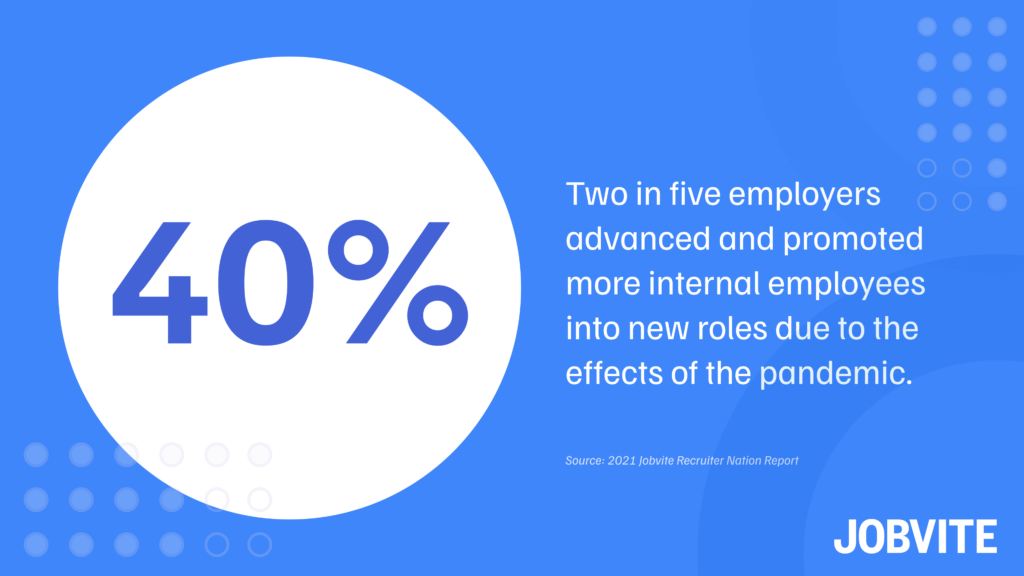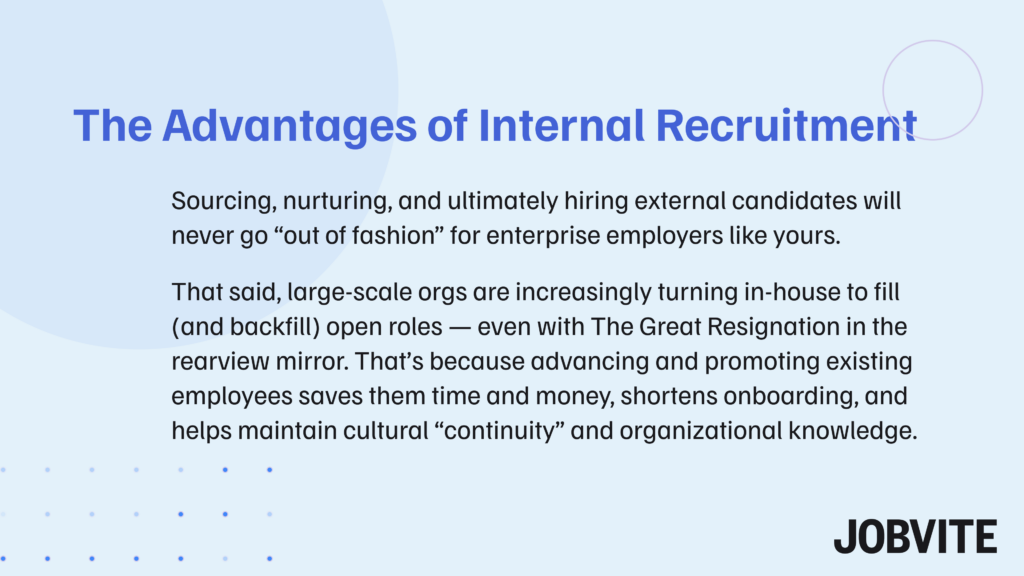An internal recruitment process isn’t just a nice-to-have for your enterprise. It’s an invaluable talent acquisition approach that leads to net benefits for both your workforce and business at large:
- Your employees can take advantage of career-pathing and mobility opportunities to move laterally or upward into positions that align with where they want to advance professionally.
- Your company (specifically, your talent acquisition team) can spend less time scouring the candidate “marketplace” for external leads and instead simply advance and promote existing full-time team members who are good fits for existing and upcoming job openings.
The question for your org isn’t “Should we focus on hiring internally or externally”? Rather, it’s “How can we best leverage internal recruitment to alleviate pressure on TA and realize our growth goals?”

Common types of internal recruiting approaches
Let’s get the bare-bones definition out of the way. Internal recruiting is the process of filling open roles across your business with current members of your workforce. (Fairly obvious, right?).
Where many large-scale employers get tripped up with leveraging this recruiting approach, though, is understanding the various nuanced approaches to internal hiring. In short, there are a few popular methods for conducting an internal recruitment strategy. These include, but are not limited to:
- Internal job boards: These are dedicated platforms for disseminating open positions within the organization, including the specific job description created for said roles.
- Job postings on the company intranet: Whereas an internal job board is a filterable” way for employees to scan job openings, your intranet (or wiki) can also act as a digital channel on which you can share news about available roles and what managers are looking for in new reports.
- Employee referrals: More specifically, we mean referrals from people managers and departmental leaders who oversee employees, can attest to their growth within the company, and can vouch for them in terms of recommending them for another position across the org. (Even a promotion.)
Regardless of the method you implement, your talent team must regularly speak with hiring managers and HR team members to identify qualified internal candidates whose skill sets and overall expertise could translate into new roles on our outside their current team is essential.
(Ideally, using an advanced ATS with built-in internal mobility capabilities for evaluating employees.)
That is, you can host formal monthly meetings in which you collectively assess employees’ strengths, weaknesses, and career aspirations to boost your odds of a successful placement for open roles.

5 notable advantages of internal recruitment
An internal recruitment strategy not only taps into the top talent already in your existing workforce but also contributes to worker retention and satisfaction. Let’s dive into some of the key benefits.
1) Save time and money
When you focus on filling open positions with existing members of your workforce, you can cut down on the need for costly job ads and postings on external platforms and simply look in-house.
Hiring from within often reduces the average recruitment process time, as internal candidates are more familiar with their org’s culture, processes, and business objectives.
What’s more, employees who are promoted or transferred within your company typically require less onboarding and training than external candidates, leading to faster “time to productivity” in their new roles. (Not to mention you don’t need to spend a week or so conducting new-hire background checks.)
2) Better retention rates
Internal mobility is directly linked to better employee retention rates. Why? Mainly, because it demonstrates to employees they have opportunities for career growth and development.
This sense of internal progression and encouragement by management often leads to increased job satisfaction and loyalty, ultimately reducing the need for costly external recruitment processes.
By actively promoting from within — and ensuring diverse talent is fairly considered for more impactful and higher-paying positions — you cultivate a more motivated and committed workforce.
The Great Resignation may be (finally) over. However, your employees are much more likely to leave your org and look elsewhere for work, if internal recruitment and mobility isn’t made a top priority.

3) Preservation of culture
Another pro of prioritizing internal recruitment? You ensure your organizational culture is preserved. That’s because existing employees are already familiar with your values and working environment.
Integrating new hires poses the inherent risk of disrupting your existing culture. Sure, your TA team works hard to find “good-fit” candidates who can fit in well with colleagues. But, this isn’t always a guarantee. Internal promotions and transfers help maintain continuity, in a way, culture-wise.
4) Reduced onboarding time
Internal hires already possess the required skills, company knowledge, and work experience that external candidates may lack. When recruiting externally, the process of onboarding a new employee can often take a lot of time. (Time that could be spent hitting the ground running in their new roles.)
External hires also require extensive training, guidance, and support from onboarding “buddies” and managers. That’s because they must familiarize themselves with your culture, values, and systems.
With internal recruitment, your current employees are already up to speed with the company’s inner-workings. They necessitate less hand-holding and supervision and have more autonomy to get going.
5) Achieve workforce planning goals
Internal recruitment is closely linked to workforce planning, with both strategies complementing each other. How? They both ensure your business remains agile and prepared for the future.
A carefully implemented internal recruiting strategy can play a vital role in succession planning, reducing talent gaps, and quickly upskilling and reskilling employees to prepare for upcoming needs.
Tapping into internal talent pipelines minimizes the potential talent gaps and aids talent acquisition teams by providing a smaller set of candidates who are known entities within the org.
Moreover, this well-oiled internal hiring mechanism allows for the seamless transition of employees into new roles. In turn, this decreases the time spent on searching for and integrating external hires.
Want to learn how Jobvite can help you thrive in today’s hiring landscape? Schedule a demo to learn how our powerful enterprise ATS can strengthen your internal recruiting strategy.





